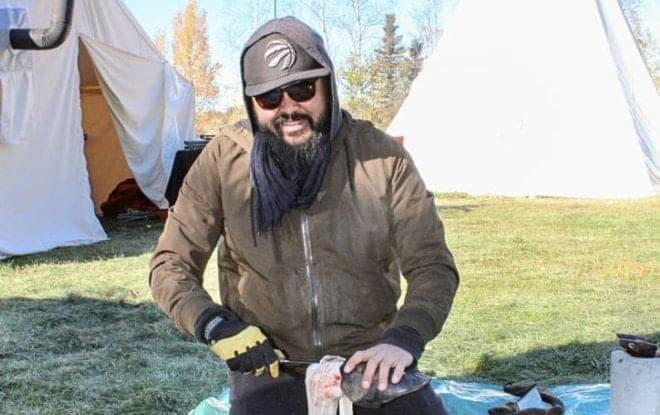After a year of preparation, organizers with Dene Nahjo have been enjoying the past week’s weather to expand the annual Urban Hide Tanning Camp a bit further.
Two big work tents, two teepees – including one for smoking – and a staff tent were stretched out at Somba K’e Park over the weekend to greet locals interested in accessing and learning about caribou hide preparation.
Now in its third year, the urban hide tanning camp is the staple event that Dene Nahjo has been putting on since its inception in 2014. This year, the group welcomed the partnership of the Aboriginal Sports Circle and the opportunity to bring in hide tanning instructors and elders from across the NWT. There are also many from Yellowknife who take part.
Mandee McDonald, managing director of Dene Nahjo, and one of the 10 co-founders of the organization, said the hide tanning camp is primarily meant to provide an opportunity for urban Indigenous peoples to access traditional cultural practices in a safe and central location. Somba K'e Park has worked out to be a great location for this purpose while providing a place where school children and tourists can get in on the educational component, she said.
“A big goal of the camp is to demonstrate the work that goes into tanning a hide,” McDonald said. “I think a lot of people don’t realize it. We want people to respect the fair price of art that goes into tanned hide in the NWT. ”

Typically the urban camp has provided community hides for participants to share for preparation, but McDonald said many participants brought their own pieces, which was different from previous years.
The urban camp's new slate of instructors and elders have also allowed for the sharing of different approaches and techniques in hide tanning throughout the North.
“There are just endless ways and every region has their own way that they do it,” McDonald said. “So we try and showcase the different ways so that it is inclusive and all are able to learn techniques from other people.”
Among the new guests were Ricky Gargan from Fort Providence, who was helping direct the creation of snowshoes with the use of babiche – sinew-like strips cut from from cleaned caribou hide.
“I love doing this kind of work because it brings back cultural life,” he said while shaping a cross piece on a snowshoe frame made of birch. “It is also really good to see the kids.”
While Gargan was working with wood with Leah Mandeville and Lawrence Cheezie in the sunshine, other workers were in a nearby tent clearing the hide for babiche making. Shawna McLeod, of the Aboriginal Sports Circle, helped organize the babiche making. She was among those involved in scraping away hide hair, clearing away the flesh and smoothing the hide for cutting into strips.
“We have all been kind of rotating as we get tired,” she said, laughing. “I’ve been here for two days already. Some hides we got were already de-haired, which made the process a bit faster but it is pretty labour intensive.
McDonald said the urban camp usually draws 100 to 200 visitors per day, which includes two school tours of 30 students each. Last year, the entire camp attracted close to 2,300 visitors, she said.
The camp will close for the season this Saturday.
